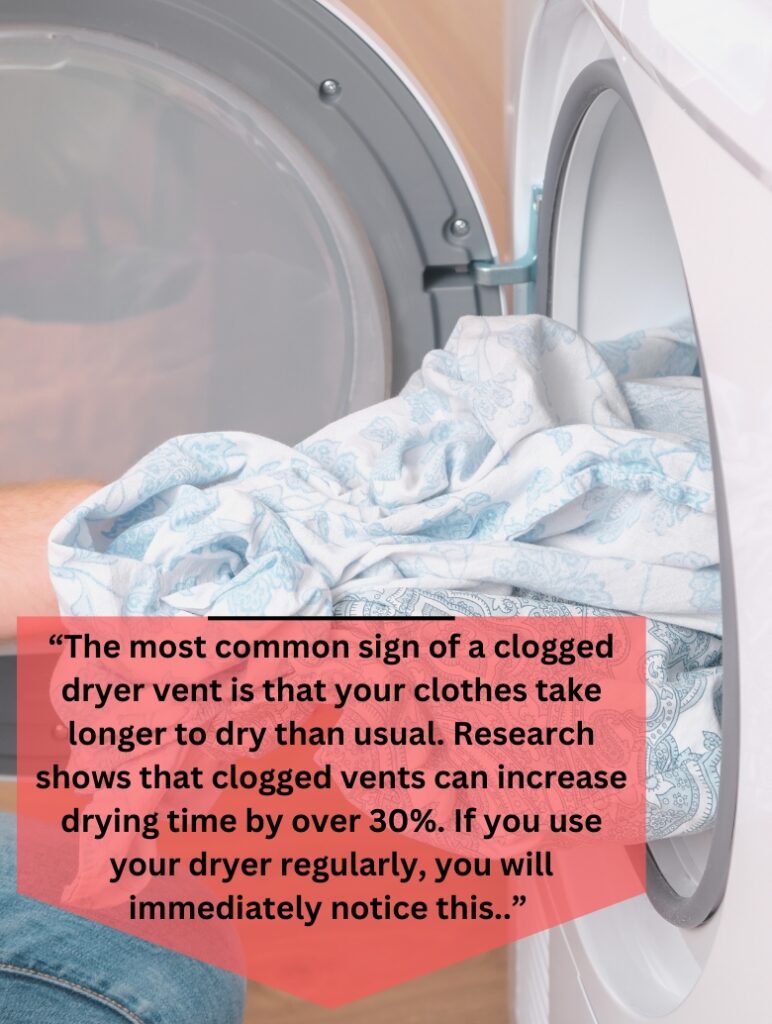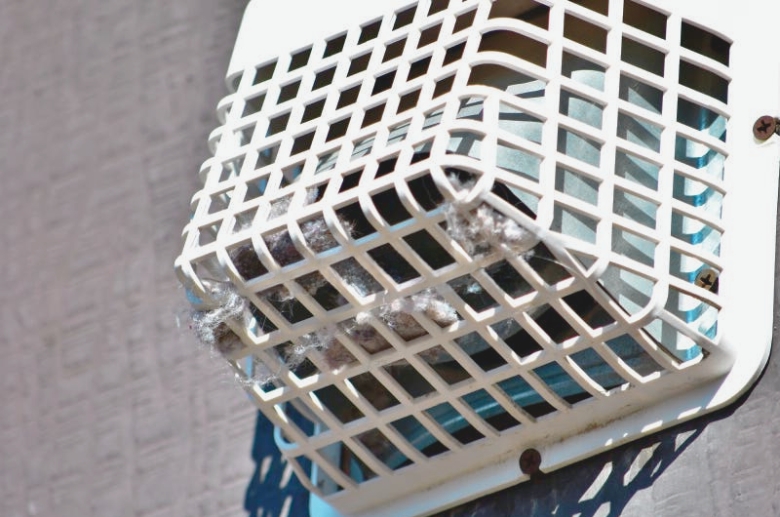Did you know that clogged dryer vents contribute to 15,000 house fires each year, resulting in $35 million in property damage? When it comes to home maintenance, the dryer vent is often overlooked. That can be a serious problem.
Understanding the signs your vent needs cleaning is crucial because it’s not just about convenience. It’s a matter of safety. Recognizing these signs early can be the difference between a well-functioning appliance and a potential fire hazard.
As a homeowner, you might often ask, ‘How do I know if my dryer vent is clogged?’ Clogged dryer vents are often due to lint accumulation or overheating, both of which are preventable issues.
This article explores how you can spot these warning signs and take proactive measures to safeguard your home.
How Do I Know if My Dryer Vent is Clogged?

The most common sign of a clogged dryer vent is that your clothes take longer to dry than usual. Research shows that clogged vents can increase drying time by over 30%. If you use your dryer regularly, you will immediately notice this.
Recognizing the warning signs of a blocked dryer is the first step in preventing a potential disaster. Here are other tell-tale signs to watch out for:
- Persistent Dampness in Clothes: If your clothes retain moisture even after a full drying cycle, it indicates restricted airflow.
- Multiple Drying Cycles Required: If you run multiple drying cycles for a single load of laundry, it’s a clear sign that something is amiss.
- Clothes Hotter than Usual: When your clothes come out of the dryer abnormally hot, it could be due to restricted airflow, which makes the appliance work harder to achieve the desired results.
- Unusual Burning Smell: A burning odor during or after a drying cycle in your laundry room can indicate that the lint inside the vent is smoldering or catching fire, which is a severe hazard.
- Accumulation of Lint: If you notice lint accumulating around the dryer or vent area, it’s a sign the dryer is not venting properly.
- Dryer Shuts Off: If your dryer constantly shuts off before the cycle ends, it could be due to overheating.
- Overheated Dryer Vent: Feel your dryer vent; if it’s excessively hot to the touch, it’s a danger sign that something is obstructing proper airflow.
——
Do You Need to Hire Chimney & Fireplace Expert?
Get free quotes from qualified experts near you. No commitment required!
——
What Happens When a Dryer Vent is Blocked?
Lots of awful things can happen if you have a blocked dryer vent. Here are some of them:
- Fire Hazard: The most critical risk is a potential house fire. The accumulated lint in the vent is highly flammable and can ignite, leading to a devastating fire.
- Gas Buildup in Gas Dryers: For those with gas dryers, a blocked vent can result in the buildup of toxic gases, such as carbon monoxide, which poses severe health risks.
- High Energy Bills: Blocked vents force the dryer to work harder and longer, significantly increasing energy bills. It can cost homeowners $20 to $50 more per month in electricity.
- Damage to Clothes and the Dryer: The excessive heat generated due to poor venting can damage clothes, creating holes or shrinking them. Also, overheating reduces the lifespan of the dryer and heating element, requiring replacement well before the machine is worn out.
Causes of a Clogged Dryer Vent
Understanding the symptoms of a clogged dryer vent can help prevent it from happening. Common culprits include:
Lint Buildup

Despite regular cleaning of traps, lint can work its way into the ductwork, getting hung up on protruding screws or in crimps or other areas. The lint trap catches most of the lint produced by the dryer. However, it has its limitations.
Some lint can escape the lint trap and venture into the vent system. Up to 30% can escape and accumulate in the vent. Moreover, when wet lint reaches a certain point, it can stick to the walls of the vent, creating pockets where more wet lint can accumulate.
External Debris and Blockages
External factors like nesting animals or debris can obstruct the vent. For example, leaves, twigs, and other outdoor debris can accumulate in the vent hood or cover, causing a blockage and preventing proper airflow.
Damaged Vent Hood
A damaged or improperly functioning vent hood can hinder proper airflow. Screens can impede airflow, reducing drying performance and increasing energy consumption by 50%.
If this hood is damaged, it may lead to blockages. Cracks, breaks, or even bird nests in the vent hood can obstruct the smooth flow of air and lint.
Incorrect Installation
Improper installation of the vent can lead to blockages. For example, when the dryer vent does not align properly with the vent through the wall, it can cause the vent hose to become twisted or bent, leading to airflow restrictions and potential lint buildup.
Infrequent Cleaning and Maintenance
Did you know that approximately 2,900 households fail to clean their dryer vents? Neglecting regular cleaning and maintenance contributes to vent blockages, leading to the majority of house fires.
How to Perform a Dryer Vent Blockage Test
To check if your dryer vent is clogged, follow these steps:
Step 1. Disconnect and Inspect Your Dryer
- Unplug your dryer from the electrical outlet or turn off the gas supply if you have a gas dryer.
- Carefully pull the dryer away from the wall, giving you access to the venting system.
- Inspect the vent connection at the back of your dryer. Look for any visible signs of lint buildup or obstructions. Remove any lint you can reach by hand.
Step 2. Use a Dryer Vent Cleaning Kit
- Purchase a dryer vent cleaning kit available at most home improvement stores. These kits include flexible rods and brushes designed to snake through the venting system.
- Assemble the cleaning kit according to the manufacturer’s instructions.
- Insert the brush into the dryer vent opening on the exterior of your home. Slowly feed the brush through the vent, pushing and pulling to dislodge lint and debris.
- Extend the brush as far into the vent as possible to reach deep within the duct.
- Rotate the brush to scrub the inner walls of the vent thoroughly. This action helps break loose any stubborn lint buildup.
- Gradually retract the brush and remove it from the vent.
Step 3. Clean the Lint Trap and Screen

- While the dryer is pulled away from the wall, clean the lint trap and screen.
- Remove the lint filter from the dryer. Use a soft brush or a vacuum cleaner attachment to remove any lint stuck in the filter and surrounding areas.
- If your lint filter is removable, wash it with warm, soapy water to remove fabric softener residue.
- Ensure the lint filter is completely dry before returning it to the dryer.
Step 4. Reconnect and Test
- Carefully push the dryer back into its original position.
- Reconnect the dryer to the electrical outlet or gas supply.
- Run your dryer on a regular heat cycle with no clothes. This step helps blow out any remaining loosened lint and debris.
- While the dryer is running, go outside to the vent opening. You should feel a strong, steady flow of warm air from the vent. If the airflow seems weak or intermittent, there may still be a blockage that requires professional service.
Step 5. Perform a Smoke Test (Optional)
- If you have concerns about residual blockages and want to be extra thorough, consider a smoke test.
- Purchase a commercially available smoke pencil or stick, which emits harmless, visible smoke.
- Turn off your dryer and disconnect it again.
- Light the smoke stick and introduce the smoke into the vent opening from the outside. If there are any blockages or leaks in the vent system, you’ll see smoke escaping from these areas inside your home.
Completing these steps will help ensure your dryer vent is free from blockages and operating efficiently, reducing the risk of fire hazards and improving drying performance.
——
Do You Need to Hire Chimney & Fireplace Expert?
Get free quotes from qualified experts near you. No commitment required!
——
DIY Tips for Maintaining a Healthy Dryer Vent
Preventing a clogged dryer vent is far easier than dealing with the consequences. Here are some DIY tips for maintaining a healthy dryer vent:

- Regular Lint Filter Cleaning – Clean the lint trap and screen after every load to minimize lint buildup. Clear ducts reduce drying times, saving utility costs and extending clothing lifespan. Importantly, this maintenance prevents electrical hazards, including fires, and reduces overall energy bills, safeguarding your home and family.
- Periodic Visual Inspection – Check the exhaust regularly. Check for any visible blockages or debris outside of your home, and address them promptly.
- Ensuring Proper Airflow – Ensure that the dryer vent has unobstructed airflow. Test it by hand for any noticeable decrease in airflow. Additionally, consider cleaning dryer vents with compressors as a more thorough method to remove stubborn lint and debris, ensuring a safer and more efficient dryer operation.
This proactive approach helps in maintaining an effective and safe dryer vent system.
Conclusion
Annual maintenance, including cleaning and inspection, can extend your dryer’s lifespan by up to 25%. Taking proactive measures ensures the safety of your home and family and saves you money.
For every dollar spent on prevention, homeowners and renters can save up to $500 on potential damages. Remember, a little maintenance goes a long way in keeping your dryer vent clear and your home safe.






